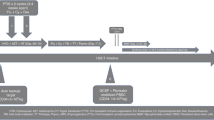Abstract
The aim of this prospective study was to determine whether treatment with a combination of GM-CSF and erythropoietin (rhEpo) can improve the anemia associated with low risk myelodysplastic syndrome (MDS), namely refractory anemia (RA), RA with ring sideroblasts (RAS), and RA with excess of blasts (RAEB) with bone marrow blasts less than 10%. Eligibility criteria included an Hb level of less than 10.5 g/dl for newly diagnosed patients, or symptomatic anemia. GM-CSF was given at a dose of 3 μg/kg s.c. on days 1–2, rhEpo at a dose of 60 U/kg s.c. on days 3–5. No treatment was given on days 6–7. Patients were followed-up with full blood count on a weekly basis. The treatment was repeated for a total of 6 weeks. At that time, if a rise in Hb above 1.5 g/dl had not been achieved, the dose of rhEpo increased to 120 U/kg. Post-treatment evaluation was performed at the completion of 12 weeks. Erythroid response was defined as good (GR), if an increase in untransfused Hb values above 2 g/dl or a 100% decrease in red blood cell transfusion requirements, over the treatment period was observed, while an increase in untransfused Hb values 1–2 g/dl or a >50% decrease in transfusion requirements, were considered as partial response. Responders continued to receive the same treatment until disease progression. Nineteen patients (13 male and six female) with a median age of 69 years were enrolled in the study. The FAB subtypes were: RA one case, RAS eight cases and RAEB 10 cases. Ten of 19 patients (52.6%) responded to the treatment: 7/19 (36.8%) achieved a GR and 3/19 (15.8%) a PR. Six of eight (75%) patients with RAS, one case with RA and 3/10 (30%) of cases with RAEB responded to treatment. Pretreatment serum epo levels were generally low (less than 200 Mu/ml) in responding patients. At the completion of the initial 12 weeks, 8/12 responding patients (5 RAS, 2 RAEB and 1 RA) continued to receive the same treatment. All responding patients with RAS continued to show an erythroid response in a time period from 3 to 24 months, whilst one patient with RA and two with RAEB did not have a continuing response at 2, 4 and 12 months, respectively. The above data suggest that the combination of rhEpo and GM-CSF should be recommended in all cases with RARS. However, the clear indication of this combination for other patients with MDS remains to be determined.
This is a preview of subscription content, access via your institution
Access options
Subscribe to this journal
Receive 12 print issues and online access
$259.00 per year
only $21.58 per issue
Buy this article
- Purchase on Springer Link
- Instant access to full article PDF
Prices may be subject to local taxes which are calculated during checkout
Similar content being viewed by others
Author information
Authors and Affiliations
Rights and permissions
About this article
Cite this article
Economopoulos, T., Mellou, S., Papageorgiou, E. et al. Treatment of anemia in low risk myelodysplastic syndromes with granulocyte–macrophage colony-stimulating factor plus recombinant human erythropoietin. Leukemia 13, 1009–1012 (1999). https://doi.org/10.1038/sj.leu.2401442
Received:
Accepted:
Published:
Issue Date:
DOI: https://doi.org/10.1038/sj.leu.2401442
Keywords
This article is cited by
-
Amifostine plus erythropoietin in a patient with low-risk myelodysplastic syndrome
Annals of Hematology (2003)
-
Pathogenesis, classification, and treatment of myelodysplastic syndromes (MDS)
Wiener Klinische Wochenschrift (2003)



